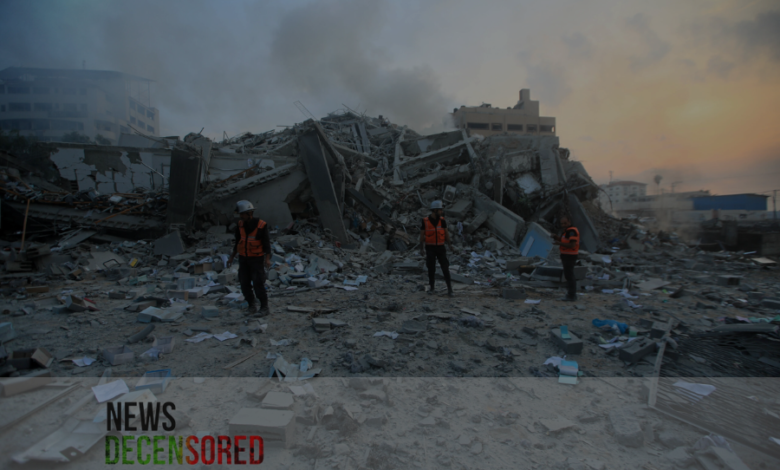UN Report: Israel’s War on Gaza Causes Unforeseen Environmental Crisis

Through the help of the United Nations, the world has again come to know about a very acute environmental crisis existing in Gaza due to the war by Israel. The new report identifies extensive deterioration of sanitary facilities, large heaps of debris, and pollution of the enclave’s environment as some of the already depressing challenges.
The debris generated by the conflict: The UN report released on Tuesday revealed that explosive weapons had created 39 million tons of litter in Gaza, and each meter of the area corresponds to 107 kilograms of debris-covered. These wastes have led to many environmental risks and health issues, as evidenced by the abovementioned waste debris.
Therefore, the currently depleted water, sanitation, and hygiene input structures in the Gaza Strip are severely compromised. All five wastewater treatment plants in Gaza contain no output provision and, therefore, have posed a severe human health problem. ”This is all systematically damaging health, food security, and the ability of societies and Gaza to recover,” UNEP’s Executive Director, Inger Andersen, said.
The confrontation has worsened environmental pollution that was already rife before the war; in Gaza, for instance, more than 92% of the water as of early 2020 was unsafe for human consumption. Israeli attacks have also impacted solar panels, another of the few environmental achievements observed in the Gaza enclave. Once, the Gaza Strip had one of the highest rates of rooftop solar panels per capita globally; however, most structures are gone.
Eoghan Darbyshire, the senior researcher for the UK-based nonprofit Conflict and Environment Observatory, opined, “In my view, large parts of Gaza cannot be made secure again within a generation, even if money is not a constraint. ”
In December, the UNEP report was sponsored by the Palestinian Environment Quality Authority to evaluate the environmental impacts on Gaza. The study’s results highlight the cumulative effects of climate change on Gaza and other occupied Palestinian territories with the Israeli military.
Historical actions have also contributed to environmental degradation. Following the Nakba in 1948, the Jewish National Fund planted monoculture pine forests on the ruins of Palestinian villages, which had a long-term negative impact on local biodiversity, as revealed by Israel’s Society for the Protection of Nature in 2013.
Agricultural production in Gaza’s agriculture over the last decade has slowly reduced, with the following highlights on the overall agricultural production. Data from the Ministry of Agriculture revealed that in 2010, olive trees had been grown in 16,815 dunams (4,155 acres of land in Gaza), and the yield was 15,386 tonnes of olives. By 2021, the area covered in olive groves was 41. Eighty-five hectares (32,850 dunum); however, the yield reduced to 10,000 tonnes of fruits, which proves high agricultural pressure.
Secondly, in recent years, Gaza has also suffered from rainfall changes; there is little rain for the cultivation of crops or large families. Regarding rainy days, it was revealed that only three decades experienced rainy days in 2020, which sharply declined to 30 rainy days in 2020 from 42 rainy days in 2018, Karam al-Aour, an environmental specialist at the Water Authority in Gaza, said.
Palestine, which gets its water supply from the West Bank territories, where Israel controls the amount of water it allows to be transported to Gaza, the only freshwater aquifer in the area, is over-exploited and polluted by sewage and seawater, as described by Amnesty International.
Other regional climate activists more recently boycotted the UN climate conference in Dubai in December due to what was going on in the Gaza Strip. This boycott adds an environmental and human dimension to the conflict, thus embodying the nature of the confrontation.
The UN report paints a bleak picture of Gaza’s environment in the future and urges international protective action, resources, and follow-up to repair the major damages and prevent more severe ecological and health impacts.
Has seen a sharp decline over the past decade. In 2010, Gaza had 16,815 dunams (4,155 acres) of olive trees producing 15,386 tonnes of olives. By 2021, the area of olive groves had increased to 32,850 dunams (8,117 acres), yet production dropped to only 10,000 tonnes of fruit, indicating severe agricultural stress.
Additionally, changes in rainfall patterns have affected Gaza’s water supply. In 2020, there were only 30 rainy days, down from 42 rainy days in 2018, according to Karam al-Aour, an environmental specialist at the Water Authority in Gaza. Israel restricts water transfers from the occupied West Bank to Gaza, and the enclave’s sole freshwater aquifer has been severely depleted and contaminated by sewage and seawater infiltration, as reported by Amnesty International.
In response to the ongoing crisis, Palestinian climate activists boycotted the UN climate summit in Dubai in December to protest Israel’s military actions in Gaza. This boycott underscores the broader environmental and human rights concerns associated with the conflict.
The UN’s findings paint a grim picture of Gaza’s environmental future, calling for immediate and sustained efforts to address the extensive damage and mitigate further ecological and health risks.




